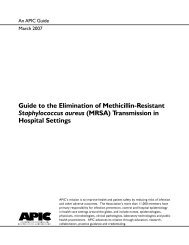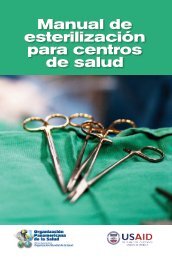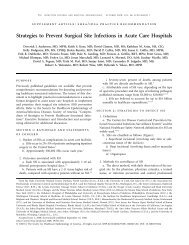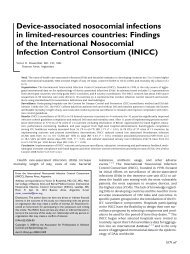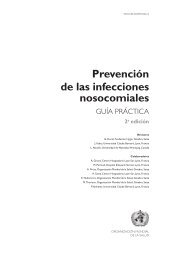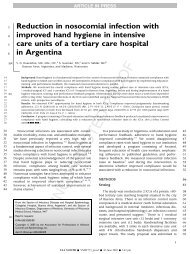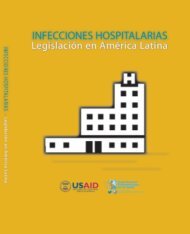Infection Control Guidelines - INICC
Infection Control Guidelines - INICC
Infection Control Guidelines - INICC
You also want an ePaper? Increase the reach of your titles
YUMPU automatically turns print PDFs into web optimized ePapers that Google loves.
Investigación original / Original research<br />
International Journal of Infectious Diseases 15 (2011) e357–e362<br />
Contents lists available at ScienceDirect<br />
Device-associated infection rates in<br />
intensive care units of Brazilian hospitals:<br />
findings of the International Nosocomial<br />
<strong>Infection</strong> <strong>Control</strong> Consortium<br />
Reinaldo Salomao, 1 Victor D. Rosenthal, 2 Gorki Grimberg, 3<br />
Simone Nouer, 4 Sergio Blecher, 1 Silvia Buchner-Ferreira, 2<br />
Rosa Vianna, 4 and Maria Ângela Maretti-da-Silva 1<br />
Suggested citation<br />
Salomao R, Rosenthal VD, Grimberg G, Nouer S, Blecher S, Buchner-Ferreira S, et al. Device-associated<br />
infection rates in intensive care units of Brazilian hospitals: findings of the International Nosocomial<br />
<strong>Infection</strong> <strong>Control</strong> Consortium. Rev Panam Salud Publica. 2008;24(3):195–202.<br />
Original Article ABSTRACT Objectives. To measure device-associated infection (DAI) rates, microbiological profiles,<br />
bacterial resistance, extra length of stay, and attributable mortality in intensive care units<br />
(ICUs) in three Brazilian hospitals that are members of the International Nosocomial <strong>Infection</strong><br />
Device-associated infection <strong>Control</strong> rates Consortium in intensive (<strong>INICC</strong>). care units in El Salvador:<br />
Methods. Prospective cohort surveillance of DAIs was conducted in five ICUs in three city<br />
International Nosocomial <strong>Infection</strong> hospitals in Brazil <strong>Control</strong> by applying Consortium the definitions of the U.S. (<strong>INICC</strong>) Centers for Findings<br />
Disease <strong>Control</strong> and Prevention<br />
National Nosocomial <strong>Infection</strong>s Surveillance System (CDC-NNIS).<br />
Lourdes Dueñas 1 Results. Between , Ana C. Bran de Casares 1 April 2003 and February 2006, , Victor D. Rosenthal 2 1 031 patients hospitalized in five , Lilian Jesús Machuca 1 ICUs for<br />
an aggregate 10 293 days acquired 307 DAIs, a rate of 29.8% or 29.8 DAIs per 1 000 ICUdays.<br />
The ventilator-associated pneumonia (VAP) rate was 20.9 per 1 000 ventilator-days; the<br />
1 Hospital Nacional de Niños Benjamin Bloom, rate for San central Salvador, venous catheter-associated El Salvador bloodstream infections (CVC-BSI) was 9.1 per 1 000<br />
2 International Nosocomial <strong>Infection</strong> <strong>Control</strong> catheter-days; Consortium, and the Buenos rate for Aires, catheter-associated Argentina urinary tract infections (CAUTI) was 9.6 per<br />
!<br />
1000 catheter-days. Ninety-five percent of all Staphylococcus aureus DAIs were caused by<br />
Abstract<br />
methicillin-resistant strains. <strong>Infection</strong>s caused by Enterobacteriaceae were resistant to ceftriaxone<br />
in 96.7% of cases, resistant to ceftazidime in 79.3% of cases, and resistant to piperacillintazobactam<br />
in 85.7% of cases. Pseudomonas aeruginosa DAIs were resistant to ciprofloxacin<br />
Introduction: This study aimed to determine the rate of device-associated, health care-associated infection (DA-HAI), the excess in length of<br />
stay, the mortality, and the hand hygiene compliance in a pediatric intensive care unit (PICU) and a neonatal ICU (NICU) in a hospital<br />
in 71.3% of cases, resistant to ceftazidime in 75.5% of cases, and resistant to imipenem in<br />
member of the International <strong>Infection</strong> <strong>Control</strong> Consortium (<strong>INICC</strong>) in El Salvador.<br />
27.7% of cases. Patients with DAIs in the ICUs of the hospitals included in this study presented<br />
Methodology: A prospective cohort, active DA-HAI surveillance study was conducted on patients admitted in the pediatric and neonatal<br />
extra mortality rates of 15.3% (RR 1.79, P = 0.0149) for VAP, 27.8% (RR 2.44, P = 0.0004)<br />
ICUs from January 2007 to November 2009. The protocol and methodology implemented were developed by <strong>INICC</strong>. Data were collected in<br />
for CVC-BSI, and 10.7% (RR 1.56, P = 0.2875) for CAUTI.<br />
the participating ICUs, and analyzed at <strong>INICC</strong> headquarters by proprietary software. DA-HAI rates were recorded by applying the definitions<br />
Conclusion. The DAI rates were high in the ICUs of the Brazilian hospitals included in this<br />
of the Centers for Disease <strong>Control</strong> and Prevention National Healthcare Safety Network.<br />
study. Patient safety can be improved through the implementation of an active infection control<br />
program comprising surveillance of DAIs and infection prevention guidelines. These ac-<br />
Results: Of 1,145 patients hospitalized in the PICU for 9,517 days, 177 acquired DA-HAIs (overall rate 15.5%), and 18.6 DA-HAIs per<br />
1,000 ICU-days. Furthermore, 1,270 patients hospitalized in the NICU for 30,663 days acquired 302 DA-HAIs (overall rate 23.8%), and 9.8<br />
tions should become a priority in every country.<br />
DA-HAIs per 1,000 ICU-days. The central line-associated bloodstream infection (CLA-BSI) rates in the NICU and PICU were 9.9 and 10.0<br />
per 1,000 catheter-days respectively. The ventilator-associated pneumonia (VAP) rate was 16.1 per 1,000 ventilator-days in the NICU and<br />
12.1 in the PICU.The catheter-associated Key words urinary Bacterial tract infection infection; (CAUTI) cross rate infection/epidemiology; was 5.8 per 1,000 catheter-days drug in the resistance, PICU. bacterial; hospitals;<br />
of infection our hospital control; were higher infection than international control practitioners; standards; infection intensive control care programs units;<br />
Conclusions: DA-HAI rates in the PICU and NICU<br />
including surveillance and antibiotic policies must length be a priority of stay; in El mortality; Salvador. Brazil.<br />
Key words: health care-associated infection; nosocomial; intensive care unit; developing country; International Nosocomial <strong>Infection</strong><br />
1 Division of <strong>Infection</strong> <strong>Control</strong>, Santa Marcelina<br />
3<br />
<strong>Control</strong> Consortium; <strong>INICC</strong>; mortality<br />
correspondence to Dr. Victor Rosenthal, Lavalleja Division of <strong>Infection</strong> <strong>Control</strong>, Porto Alegre General<br />
Hospital, Porto Alegre, Hospital, São Paulo, Brazil.<br />
305, Floor 9, Apt B, (1414) Buenos Aires, Argen-<br />
Brazil.<br />
International Journal of Infectious Diseases<br />
journal homepage: www.elsevier.com/locate/ijid<br />
Device-associated infection rates in adult intensive care units of Cuban university<br />
hospitals: International Nosocomial <strong>Infection</strong> <strong>Control</strong> Consortium (<strong>INICC</strong>) findings<br />
H. Guanche-Garcell a , O. Requejo-Pino b , V.D. Rosenthal c, *, C. Morales-Pérez a ,<br />
O. Delgado-González b , D. Fernández-González b<br />
a Joaquín Albarrán Domínguez Surgical Training Hospital, Havana, Cuba<br />
b Gral. Calixto García University Hospital, Havana, Cuba<br />
c International Nosocomial <strong>Infection</strong> <strong>Control</strong> Consortium, Buenos Aires, Argentina<br />
ARTICLE INFO<br />
SUMMARY<br />
Investigación original / Original research<br />
Article history:<br />
Objectives: To determine the rate of device-associated healthcare-associated infection (DA-HAI),<br />
Received 25 June 2010<br />
microbiological profile, length of stay (LOS), extra mortality, and hand hygiene compliance in two<br />
Received in revised form 20 December 2010<br />
intensive care units (ICUs) of two hospital members of the International <strong>Infection</strong> <strong>Control</strong> Consortium<br />
Accepted 1 February 2011<br />
(<strong>INICC</strong>) of Havana, Cuba.<br />
Methods: An open label, prospective cohort, active DA-HAI surveillance study was conducted on adults<br />
Corresponding Editor: Ziad Memish, Riyadh, admitted to two tertiary-care ICUs in Cuba from May 2006 to December 2009, implementing the<br />
Saudi Arabia<br />
methodology developed by <strong>INICC</strong>. Data collection was performed in the participating ICUs, and data<br />
Device-associated infection rates and mortality<br />
were uploaded and analyzed at the <strong>INICC</strong> headquarters on proprietary software. DA-HAI rates were<br />
registered by applying the definitions of the US Centers for Disease <strong>Control</strong> and Prevention National<br />
Healthcare Safety Network (CDC NHSN). We analyzed the mechanical ventilator-associated pneumonia<br />
Keywords:<br />
in intensive care units of Peruvian hospitals:<br />
Nosocomial infection<br />
Hospital infection<br />
Health care acquired infection<br />
findings Cuba of the International Nosocomial<br />
Developing country<br />
Intensive Care Unit<br />
<strong>Infection</strong> <strong>Control</strong> Consortium<br />
(VAP), central line-associated bloodstream infection (CLA-BSI), and catheter-associated urinary tract<br />
infection (CAUTI) rates, microorganism profile, extra length of stay (ELOS), extra mortality, and hand<br />
hygiene compliance.<br />
Results: During 14 512 days of hospitalization, 1982 patients acquired 444 DA-HAIs, an overall rate of<br />
22.4% (95% CI 20.6–24.3) or 30.6 (95% CI 27.8–33.5) DA-HAIs per 1000 ICU-days. The CLA-BSI rate was 2.0<br />
(95% CI 1.2–3.1) per 1000 central line-days, the VAP rate was 52.5 (95% CI 47.2–58.3) per 1000 ventilatordays,<br />
and the CAUTI rate was 8.1 (95% CI 6.5–10.0) per 1000 catheter-days. LOS of patients was 4.9 days<br />
for those without DA-HAI, 23.3 days for those with CLA-BSI, and 23.8 days for those with VAP. CAUTI LOS<br />
was not calculated due to the lack of data. Extra mortality was 47% (relative risk (RR) 2.42; p = 0.0693) for<br />
VAP and 17% (RR 1.52; p = 0.5552) for CLA-BSI. The only patient with CAUTI died, but there was too little<br />
mortality data regarding this infection type to consider this significant. Escherichia coli was the most<br />
commonly isolated microorganism. The overall hand hygiene compliance was 48.6% (95% CI 42.8–54.3).<br />
Conclusions: DA-HAI rates, LOS, and mortality were found to be high, and hand hygiene low. It is of<br />
primary importance that infection control programs that include outcome and process surveillance are<br />
implemented in Cuba.<br />
ß 2011 International Society for Infectious27<br />
Diseases. Published by Elsevier Ltd. All rights reserved.<br />
Cuellar LE, Fernandez-Maldonado E, Rosenthal VD, Castaneda-Sabogal A, Rosales R, Mayorga-<br />
Espichan MJ, et al. Device-associated infection rates and mortality in intensive care units of Peruvian<br />
hospitals: findings of the International Nosocomial <strong>Infection</strong> <strong>Control</strong> Consortium. Rev Panam Salud<br />
Publica. 2008;24(1):16–24.<br />
Luis E. Cuellar, 1 Eduardo Fernandez-Maldonado, 2 Victor D. Rosenthal, 3<br />
Alex Castaneda-Sabogal, 4 Rosa Rosales, 1 Manuel J. Mayorga-Espichan, 2<br />
Luis A. Camacho-Cosavalente, 3 and Luis I. Castillo-Bravo 1<br />
Suggested citation<br />
1. Introduction<br />
surveillance has been reported by the US Centers for Disease<br />
<strong>Control</strong> and Prevention (CDC) Study of the Efficacy of Nosocomial<br />
In the USA, as well as in several other high-income countries, <strong>Infection</strong> <strong>Control</strong> (SENIC) as an efficacious tool to reduce DA-HAIs.<br />
ABSTRACT Objectives. To measure device-associated infection (DAI) rates, microbiological profiles,<br />
2



